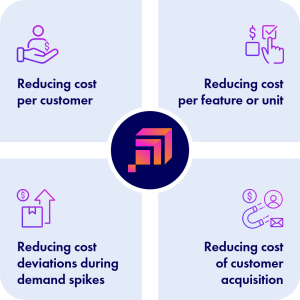In the digital era, the cloud has become the backbone of enterprise IT infrastructure. However, with great power comes great responsibility—and costs. Cloud overspending has emerged as a critical concern for businesses globally. Understanding the root causes of this financial drain – along with effective methods to address it – is critical not only for a robust cloud strategy but for every business bottom line.
Common Reasons for Cloud Overspending
Overprovisioning: It’s common for businesses to overestimate their resource needs, leading to excess reserved resources without realizing the financial ramifications until the cloud invoice is received.
Underutilization: Organizations often pay for more cloud services than they actually use, failing to align their spending with actual consumption.
Suboptimal Design: Without a meticulously crafted cloud architecture, companies can find themselves locked into costly structures that are difficult to scale or adjust.
Lack of Understanding: A general misunderstanding of cloud technology often leads to poor decision-making and wasted investment.
Orphaned Resources: Cloud services that remain active after they’re no longer needed can accumulate unnoticed expenses.
Manual Containerization: Manual processes in cloud management are not only outdated but also inefficient and costly.
Skill Shortages: The lack of skilled personnel to manage and optimize cloud infrastructure can lead to suboptimal resource utilization.
Compliance and Risk Management: Adhering to compliance standards and managing risks can be expensive without a strategic approach.
How proSkale Addresses Cloud Overspending
While cloud cost optimization is often discussed in terms of well-known practices like selecting right-sized resources, leveraging reserved instances, and shutting down unused instances, proSkale incorporates the next level of techniques to drive further cost savings:
Spot Instances with Checkpointing: Using spot instances for stateless or fault-tolerant applications is a common strategy. However, combining spot instances with checkpointing mechanisms allows long-running processes to be paused and resumed as spot instance prices fluctuate, saving costs without losing progress.
Automated Policies for Scaling: Implementing more sophisticated auto-scaling policies that consider a broader set of metrics can optimize costs. For instance, scaling not just on CPU or memory usage, but also on custom application metrics such as the number of active users, transaction rates, or even business-specific metrics, can ensure that scaling happens just as needed.
Ephemeral Environments: Using infrastructure as code, it is possible to spin up and tear down development, testing, or staging environments as needed, rather than keeping them running 24/7.
Right-Sizing Services: This involves not just selecting the right-sized compute instances, but also evaluating managed services. Sometimes, managed services can be more cost-effective than self-managed clusters, even if they appear more expensive on a per-resource basis.
Storage Class Analysis: Frequently accessed data can be stored on higher-performance storage, while infrequently accessed data can be moved to lower-cost storage classes. Implementing lifecycle policies to automate this process can yield substantial savings.
Anomaly Detection in Billing: Implementing tools and practices to detect billing anomalies can prevent unexpected costs due to misconfigurations or errors.
Network Cost Management: Optimizing data transfer processes and choosing the right regions for services helps minimize cross-region or internet data transfer costs.
Resource Tagging and Cost Allocation: By tagging resources accurately, it becomes easier to allocate costs to the correct departments, projects, or customers, which can reveal unexpected cost centers and opportunities for savings.
Cost Attribution Reports: Detailed cost attribution reports can help in understanding the exact cost drivers and can lead to more targeted optimization efforts.
Containerization: Using containers can lead to more efficient use of underlying resources, further reducing costs.
Architectural Refactoring: Changing the system architecture to use more cost-effective services or patterns (like event-driven architecture) can result in long-term savings.
proSkale’s Approach
proSkale’s approach is proactive and preventive and is backed by our cloud and FinOps experts. We believe in tackling cloud overspending head on, helping our customers direct their attention and dollars towards strategic initiatives. By closely aligning our cloud experts with your cloud infrastructure, proSkale not only prevents overspending but also enhances overall operational efficiency.
To combat cloud overspending, proSkale implements several tailored strategies:
Thorough Assessments: We start by conducting a detailed analysis of your current cloud usage and expenses to identify inefficiencies.
Custom Policy Implementation: We assist in the development and enforcement of cloud usage policies tailored to your business operations, promoting cost efficiency and compliance.
Continuous Monitoring and Reporting: proSkale offers ongoing monitoring and strategic insights to prevent and address overspending efficiently.
Education and Enablement: We empower your teams with the knowledge to make informed cloud decisions through workshops and training sessions.
Strategic Consulting: proSkale offers strategic consulting services to align your cloud spending with long-term business goals, ensuring sustainable growth and profitability.
Advanced Cost Management Metrics with proSkale
In addition to the strategies outlined above, proSkale employs advanced metrics and methodologies to enhance cloud cost optimization further, directly linking cloud costs to business outcomes:

Cost per customer: Understanding the cloud cost implications of each new customer helps in fine-tuning acquisition strategies and pricing models.
Cost per feature or unit: Tying in and incorporating cloud cost to the building and maintenance of each feature and comparing it to the feature’s estimated revenue generation aids in identifying features that offer the best return on investment.
Cost deviations during demand spikes: proSkale can analyze cloud cost spikes to determine the cause and whether it correlates with increased revenue.
Cost of customer acquisition: proSkale’s strategic consulting includes assessing the cloud cost component of acquiring new customers, ensuring that customer growth aligns with cost-effective scaling.
Positively impacting business outcomes makes the ROI of engaging proSkale’s cloud experts a no-brainer. Take the first step towards cloud cost efficiency. Contact proSkale today to schedule your cloud spending assessment and start optimizing your cloud investments.

